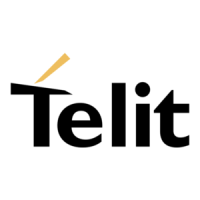
Do you have a question about the Telit Wireless Solutions LE910C1 Series and is the answer not in the manual?
| Operating Temperature | -40°C to +85°C |
|---|---|
| Technology | LTE Cat 1 |
| Frequency Bands | LTE FDD: B1/B2/B3/B4/B5/B7/B8/B12/B13/B18/B19/B20/B25/B26/B28/B66; LTE TDD: B38/B39/B40/B41; UMTS: B1/B2/B4/B5/B8; GSM: 850/900/1800/1900 MHz |
| Interface | USB 2.0, UART, GPIO |
| Voice Support | Digital Audio |
| GNSS | GPS, GLONASS, BeiDou, Galileo |
| Approvals | CE, FCC, PTCRB, GCF |
| Data Rate | LTE Cat.1: 10 Mbps DL, 5 Mbps UL |
Defines the document's purpose and applicability to the LE910C1 module variants.
Provides contact details for Telit's Technical Support Center (TTSC) for inquiries.
Lists references to other relevant Telit documentation for further information.
Introduces the LE910C1 LTE series for IoT applications and its basic use case.
Details telematics applications where LE910C1 can be used, like emergency calls and tracking.
Lists key functions and features of the LE910C1, including modem, audio, and interfaces.
Specifies operating and storage temperature ranges and RoHS compliance.
Details operating frequencies for GSM, WCDMA, and LTE modes per regional variant.
Provides typical sensitivity levels and maximum output power values.
Covers the physical dimensions and weight of the LE910C1 module.
Details the pin assignments for various interfaces like USB, UART, SPI, and SD/MMC.
Specifies mandatory signals that require connection regardless of end application use.
Illustrates the physical layout of the Land Grid Array (LGA) pads on the module.
Lists voltage limits that must not be exceeded to prevent module damage.
Specifies optimal ambient temperature and supply voltage ranges for operation.
Defines interface logic levels, primarily 1.8V CMOS, for various pads.
Describes the procedure and circuit for powering on the module using the ON/OFF# pad.
Explains the module's startup sequence, including initialization and activation states.
Details methods for powering down the module via software or hardware shutdown.
Outlines nominal supply voltage, range, and maximum ripple on input supply.
Provides guidelines for electrical design, thermal management, and PCB layout.
Specifies requirements for GSM, WCDMA, and LTE antennas and PCB transmission lines.
Details requirements for GNSS antennas, including pre-filters and connection guidelines.
Describes the USB 2.0 interface for control, data transfer, and firmware updates.
Details the module's two serial ports (MODEM SERIAL PORT 1 & 2) and RS232 translation.
Covers SPI, I2C, SD/MMC, and SDIO interfaces for external device connectivity.
Explains the digital audio interface (DVI) for connecting external audio codecs.
Shows mechanical dimensions and surface finishing for module mounting.
Provides a recommended PCB footprint and placement inhibit area for the module.
Recommends Non Solder Mask Defined (NSMD) type for PCB solder pads.
Recommends using 'no clean' solder paste and details the solder reflow profile.
Suggests adding test pads for checking connections and testing module performance.
Explains the importance of bypass capacitors for power supply stability.
Describes options for downloading software and debugging the module.
Details how LE910C1 modules are packaged on trays for SMT handling.
Describes packaging options for LE910C1 modules on reels.
Addresses the Moisture Sensitive Device Level 3 requirements for handling.
Covers FCC and ISED regulatory compliance, including interference and exposure notices.